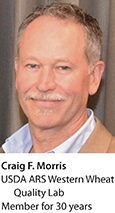 Q: What is your current position and what type of work do you do?
Q: What is your current position and what type of work do you do?
A: I am a director of the USDA ARS Western Wheat Quality Lab located at Washington State University. I am a cereal chemist who researches the genetic basis of wheat grain and flour quality.
Q: When and how did you first decide you wanted to work in cereal grain science?
A: I grew up on a corn–soybean farm in Iowa, so I’ve always had a passion for agriculture. It was in graduate school (Kansas State University), where I really developed a love for wheat. A great mentor and member of my graduate committee, Prof. Jon Faubion, had a hugely positive influence on me.
Q: How have you been involved with the AACCI — Cereals & Grains Association? How has your involvement with the association enriched your career?
A: I have had the honor to serve as editor-in-chief of Cereal Chemistry, have served on the AACCI Board of Directors, and, with Dr. Lydia Midness, am guest editing the 2019 November-December issue of Cereal Foods World. I have enjoyed working in several of the AACCI Divisions and on the Approved Methods Technical Committees. I served a couple of terms on the Cereal Chemistry Editorial Board and enjoy serving as a manuscript reviewer. There is no shortage of volunteer opportunities in the AACCI — Cereals & Grains Association. Early on, it was a great opportunity to co-chair sessions at the annual meetings—something I am still doing! The association has always been my professional home, and the place where my family of colleagues interacts.
Q: In 2019, Cereal Foods World (CFW) is focusing on the global food system (GFS). What is your perspective on how global societal and technology trends are affecting cereal science and the cereal grain industry overall? How will cereal scientists need to adapt to these global trends?
A: We live in a world of “haves,” “have nots,” and many people in between. Cereals and other grains are the foundation of human civilization, and we must consider how best to feed a projected 10 billion people in a sustainable way. At the same time, we also need to understand people who have significantly higher purchasing power and want convenience, safety, nutrition, taste, and societal considerations.
As an illustration, I work with wheat breeders to develop high-quality “commodity” wheat that can be delivered efficiently and affordably, but I also work on niche specialty wheats that can provide food processors and consumers with novel cereal foods. There is a spectrum, and none are mutually exclusive.
Q: This issue of CFW explores processing in the context of the GFS. Do you have any perspectives on the challenges and opportunities associated with the global expansion of the food chain and the dynamics of the global food trade?
A: Again, for much of the world, shiploads of wheat (e.g., a Panamax ship may hold 60,000–80,000 metric tons) must be produced, transported, milled, processed (e.g., baked, etc.), and delivered to consumers in the most efficient and cost-effective way possible. Calories, cost, and nutrition are paramount. For others, however, products that are new, novel, and maybe have a societal story behind them (e.g., “know your farmer”) are driving consumer food choices.
Q: What’s next for you?
A: I thoroughly love what I do and am lucky to work in such a dynamic and satisfying field. My team and I continue to explore new compositions and types of wheat. Waxy wheat, for example, is finally taking off; our current work on soft kernel durum has huge potential; and most recently, we are exploring ways to “reinvent” oats!
